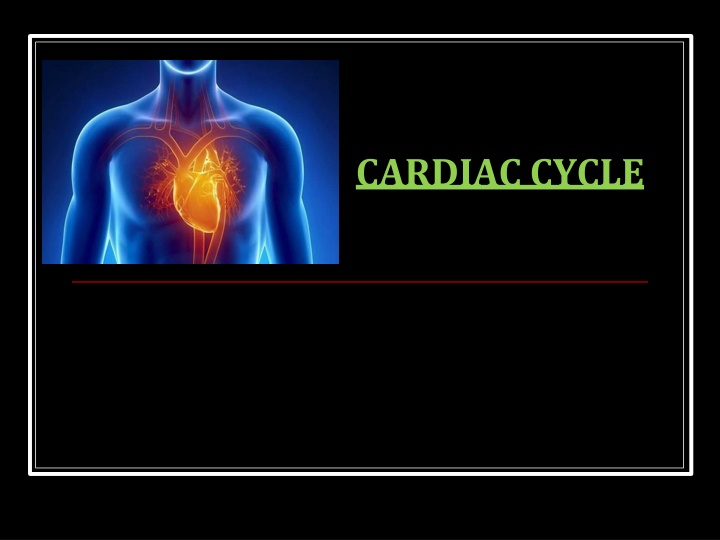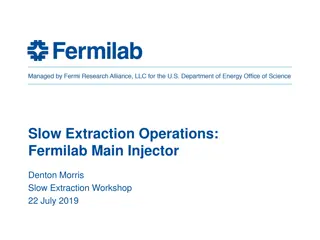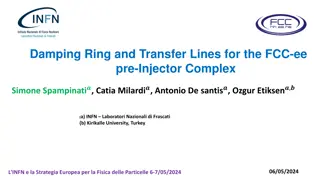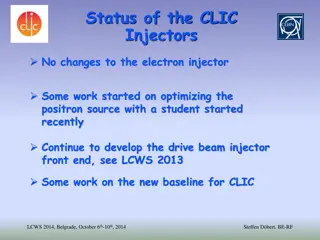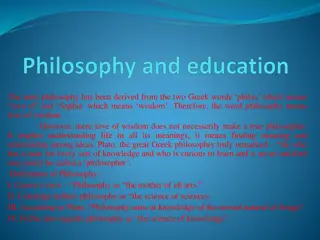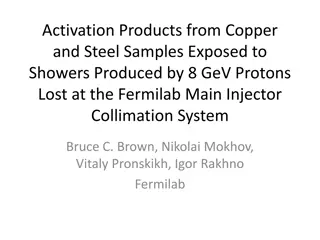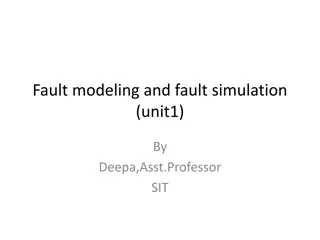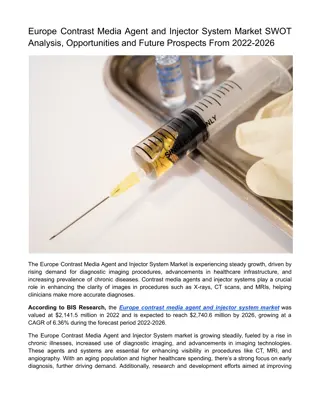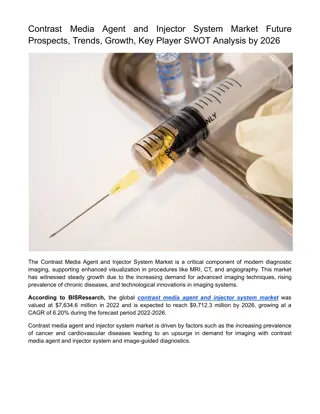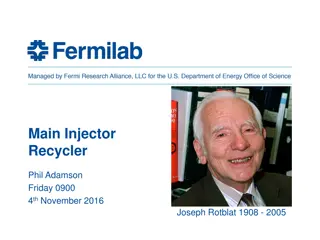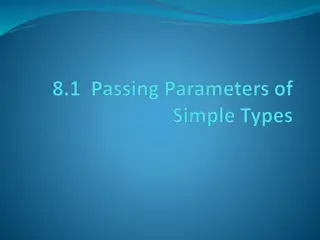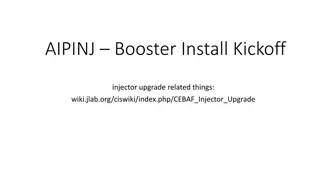CompactLight Injector Design Philosophy and Simulation Parameters
The project discusses the design philosophy and simulation parameters of a CompactLight injector using S-band gun and X-band booster for acceleration. It covers RF parameters, laser parameters, and requirements for CompactLight, with detailed case studies on acceleration and velocity bunching. The results and discussions provide insights into emittance, energy spread, and beam properties.
Uploaded on Apr 15, 2025 | 1 Views
Download Presentation

Please find below an Image/Link to download the presentation.
The content on the website is provided AS IS for your information and personal use only. It may not be sold, licensed, or shared on other websites without obtaining consent from the author.If you encounter any issues during the download, it is possible that the publisher has removed the file from their server.
You are allowed to download the files provided on this website for personal or commercial use, subject to the condition that they are used lawfully. All files are the property of their respective owners.
The content on the website is provided AS IS for your information and personal use only. It may not be sold, licensed, or shared on other websites without obtaining consent from the author.
E N D
Presentation Transcript
INTRODUCTION The heart as a pump. 2 separatepump in series. Systole contraction Diastole relaxation. Cardiac cycle both electrical & mechanical events from beginning of one heart beat to beginning of next.
DURATION OF CARDIAC CYCLE IF NormalHeart rate is 75 beats /min Durationof one (1) beat = 60/75 = 0.8 sec.
PHASES OF CARDIAC CYCLE Atrialcycle (0.8) Atrialsystole (0.1) Atrialdiastole (0.7) Ventricularcycle (0.8) Ventricular systole (0.3) Ventricular diastole. (0.5)
ATRIALCYCLE Atrial systole (0.1) Coincidewith last rapid filling phase of ventricles. Before this valves are open, ventricles relaxed with already75% blood Contraction add only remaining25% blood.
EFFECTS OF ATRIAL SYSTOLE. Intraatrialpressure Right 4-6mmHg. Left 7-8 mm Hg. Intraventricular pressure. Narrowingof originof great veins- Decreasing Venous Return.
ATRIAL DIASTOLE (0.7) Coincide with Ventricular Systole & mostof the ventricular diastole. AtriaRelax gradual filling of atria pressure slowly increases.
VENTRICULARCYCLE Ventricularsystole (0.3) phases PhaseofIso-Volumic (Iso-metric) Contraction Phase of ventricular ejection. Rapidphase Slowphase.
VENTRICULAR CYCLE (cont.) Phase of Iso-Volumic (Iso-metric) Contraction(0.05) When intra-ventricularpressure rises closes AV valves semilunar valves not yet open so contracts as closed chamber. No change in volume so called Iso-Volumic contraction. Sharp rise in Intraventricular pressure
VENTRICULAR CYCLE (cont.) Phase of ventricular ejection (0.25) begins with opening of semilunar valves. Rapid phase (0.1) 2/3rdof stroke volume ejected. Rt ventricles velocity is less thanleft but durationis more. Slowphase.(0.15) 1/3rdof stroke volume ejected.
VENTRICULARCYCLE VenntricularDiastole (0.5) phases Protodiastole Isovolumicor Isometric Relaxation phase. Rapid passive filling phase. Reduced filling& Diastosis Last rapid filling phase.
PROTODIASTOLE 0.04sec. Ventricularsystole ends ventricles relax Intraventricular pressure falls blood comes back from vessels to ventricles semilunar valves closes 2ndheart sound CausesDiacroticNotch in pulse.
ISOVOLUMIC OR ISOMETRIC Lastsfor 0.06 sec Begins with closure of semilunarvalves. A-V valves not yet open relax as closed chamber as volume remainssame Iso-Volumicrelaxation. Ends with opening of A-V valves
RAPID PASSIVE FILLING PHASE. As A-V valves open atria till now in diastole filled with venous return with increased pressure causes rapid passive filling of ventricles( 3rd heart sound)
REDUCED FILLING & DIASTOSIS As ventricles filling continues pressure differences reduces so filling rate decreases Diastasis. Total blood transferredwith rapid & slow filling is 75% of total atrialblood.
LAST RAPID FILLING PHASE. As said earlier it coincidewith atrial systole add remaining 25 % of blood to ventricles. With this ventricular cycle completes.
EVENTS DURING CARDIAC CYCLE Pressurechanges. In Ventricles InAtria. InAorta In PulmonaryArtery. Volumechanges. In ventricles DuringAtrial systole DuringVentricular systole.
PRESSURECHANGES. IN VENTRICLES DuringAtrialsystole Ventricularsystole Ventriculardiastole.
PRESSURECHANGES. IN VENTRICLES DURING ATRIALSYSTOLE Which coincide with lastrapidfilling phase of ventricles pressure in ventricles is just above zero with contraction pressurerises Right 6-7mmHg. Left 7-8 mmHg.
PRESSURE CHANGES. IN VENTRICLES DURING VENTRICULAR SYSTOLE Iso-volumic contraction 80mm Hg. Rapid ejection phase 120mm Hg left side. 80 mm Hg right side. Slow ejection phase. Pressurestarts declining.
PRESSURE CHANGES. IN VENTRICLES VENTRICULAR DIASTOLE. Protodiastole pressure drops rapidly upto 80 mmHg. Iso-volumic or Isometric Relaxationphase 2-3 mm Hg. Rapid passive filling phase furtherfalls (GH) Reduced filling & Diastosis Pressurejust above zero. Last rapid filling phase.
PRESSURE CHANGES IN ATRIA. DURING ATRIAL SYSTOLE Just before systole pressure is just above zero & slightly greater than ventricles During systole sharply increasesleft 7-8 mm Hg & right6-7 mmHg. Causes a wave in JVP.
PRESSURE CHANGES IN ATRIA. DURING VENTRICULAR SYSTOLE. Isometric contraction due to sharp rise in pressure- A-V valves bulges in atria c wave Ejectionphase Intra-atrialpressuredrops sharply. As papillary muscles pull A-V valves down atrial volume rises & pressure decreases.
PRESSURE CHANGES IN ATRIA. DURING VENTRICULAR DIASTOLE. Iso-volumicrelaxation phase as A-V valve remains closed, due to venous filling form v wave in JVP Rapid passive filling phase As A-V valves open passive filling Atrial pressure drops down just above zero.
PRESSURE CHANGES IN AORTA DURING ATRIAL SYSTOLE Pressure in Aorta is 80 mm Hg.
PRESSURE CHANGES IN AORTA DURING VENTRICULAR SYSTOLE During ventricular systole aortic pressureis lessthan intraventricular pressure. Assystolecontinues pressure reaches equal to ventricles (120mm Hg)
PRESSURE CHANGES IN AORTA DURING VENTRICULAR DIASTOLE During Protodiastole Aortic pressureis higher than ventricles back flow of blood 2ndHS & Diacroticnotch. Rest of diastole aortic pressure decline slowly up to 80 mm Hg.
PRESSURE CHANGESIN PULMONARY ARTERY. Similarto Aorta but pressuresare low. Systolic pressure goes up to 15-18 mm Hg. Diastolicpressureup to 8-10 mm Hg.
VOLUMECHANGES. IN VENTRICLES DuringAtrial systole Coincidewith last rapid filling phase Out of total 130 ml (EDV) in ventricles, 105 ml (75%) blood already reaches ventriclebefore systole 25 ml (25%) transferred due to atrial systole.
VOLUMECHANGES. IN VENTRICLES DuringVentricular systole. Iso-volumiccontraction no change Ejectionphase 80 ml stroke volume, Ejectionfraction (80/130)= 65% ESV = 50 ml.
VALVULAR EVENTS (HEART SOUNDS) Firstheartsound Secondheartsound Third heartsound Fourth heartsound
FIRST HEART SOUND Cause closure of A-V valves. Characteristics LUBB , duration -0.15 sec, freq 25-45 Hz. Site for auscultation Mitral& Tricuspid area. Correlation withECG coincide with peak of R wave.
SECOND HEART SOUND Cause closure of semilunarvalves. Characteristics DUBB , duration 0.12 sec, freq 50Hz. Site for auscultation Aortic& Pulmonaryarea. Correlation with ECG coincidewith T wave.
THIRD HEARTSOUND Cause Inrush of blood during rapid filling phase. Characteristics Duration 0.1sec. Correlationwith ECG appears between T & P wave.
FOURTH HEARTSOUND Cause last rapid filling phase. Characteristics Duration0.03 sec,freq- 3 Hz. Correlationwith ECG appears between P wave 7 onset of Q wave.
CARDIACMURMURS Abnormalheartsounds during cardiac cycle. Mechanism of production produced due to turbulent blood flow. Thursday, December 28, 2017
CARDIACMURMURS Causes Valvularstenosis Valvularinsufficiency Valvularseptal defect. Coarctationof aorta Types Systolic Diastolic Continuous.
ECG The ECG produces a trace of the electrical activity. The trace of a healthy person has what s know as a PQRSTshape . Its waveforms consist of regions labelled by the letters P, Q, R, S and T. The wave labelled P corresponds to the excitation and contraction of the atria during atrial systole. The QRS complex corresponds to the excitation and contraction of the ventricles during ventricular systole. Finally, the T wave corresponds the diastole phase.
